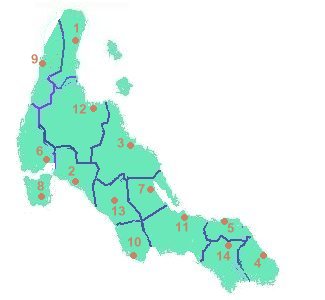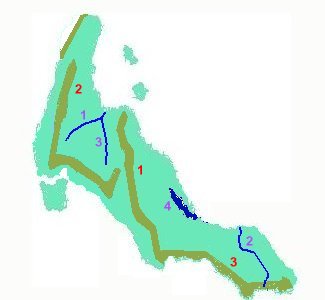The South Region of Thailand
The South region of Thailand has a total area of 70,715.20 sq. km.
and is comprised of 14 provinces which are as follows:
Provinces of South Thailand
 |
|
No. |
Province |
Area (sq. km.) |
Pop. as of 1997 |
|
1 |
Chumphon |
6,009.01 |
448,087 |
|
2 |
Krabi |
4,708.51 |
344,610 |
|
3 |
Nakhorn Sri Thammarat |
9,942.50 |
1,511,857 |
|
4 |
Narathiwat |
4,475.43 |
646,871 |
|
5 |
Pattani |
1,940.36 |
590,735 |
|
6 |
Phang Nga |
4,170.90 |
229,704 |
|
7 |
Phattalung |
1,940.36 |
498,805 |
|
8 |
Phuket |
543.03 |
221,835 |
|
9 |
Ranong |
3,298.05 |
151,868 |
|
10 |
Satun |
2,478.98 |
253,177 |
|
11 |
Songkhla |
7,39.89 |
1,191,233 |
|
12 |
Surat Thani |
12,891.47 |
861,233 |
|
13 |
Trang |
4917.52 |
576,060 |
|
14 |
Yala |
4,521.08 |
418,790 |
Geography and Climate
Mountains and rivers: The South has 3 significant mountain ranges and
4 significant rivers:
Mountains, Rivers and Lakes
of South Thailand
 |
|
Mountain Ranges
|
Rivers and Lakes
|
|
No. (Red) |
Mountain Range |
No. (Purple) |
River or Lake |
|
1 |
Nakhorn Sri Thammarat |
1 |
Khirirat River |
|
2 |
Phuket |
2 |
Tani River |
|
3 |
San Kalakhiri |
3 |
Tapi River |
|
|
|
|
4 |
Songkhla Lake |
Plains: Virtually all of the South's plains are along the coast and rivers
run through them.
Influences on Climate: The South's climate is influenced by the southwest
monsoon and northwest monsoon winds and sea breezes, as well as depression
storms. The Phuket and Nakhorn Sri Thammarat mountain ranges block the
southwest monsoon winds and thus the south and west of the region (especially
Ranong Province) are one of the rainiest parts of Thailand.
Temperature: In any given month, the South has very limited temperature
range with a difference between the high for the month and the low for
month of 3 C. In 1977 the highest average temperature in the South was
at Trang Province and Hat Yai District in Songkhla Province (32.8 C) and
the lowest average was at Chumphon (12.8 C).
Rainfall: The western part of the region gets most of its rain between
May and October (more than 200 mm per month) and the least from December
to March (less than 100 mm per month). The western part of the region gets
most of its rain between September and November (more than 200 mm per month)
and the least from February to April (less than 100 mm per month).
Seasons: The South has 2 seasons, the rainy season, from May to December,
and the dry season, from January to April.
Places of Interest
The South has many places of interest, for example:
1. 40 million year old mollusk fossils, Krabi Province
Formerly a freshwater pond, the freshwater snails
that lived there were cast into shelly limestone when sea water flowed
into the lake as a result of changes on the earth's crust.
2. Phi Phi Islands, Krabi Province
The 6-island archipelago has beautiful views as
well as diving spots to see beautiful coral reefs. The environmentally-controversial
film "The Beach" was filmed here.
3. Similan and Surin Islands, Phang Nga Province
Best visited during March, when there is no monsoon,
both archipelagos feature diving spots to see beautiful coral reefs as
well as various types of fishes and sea animals. The Similan Islands also
feature strange looking rock formations, with the islands' signature rock
formation being in the shape of a sailboat.
4. Various beaches of Phuket Province
Phuket Province is one of the best beach resorts
of the South. The province has beautiful beaches. The best beaches for
swimming and diving are Patong and Kata beaches.
5. Kra Isthumus, Ranong Province
44 km. wide for the east to the west, this point
is the narrowest point of the Malayu Peninsula.
6. Hot water springs, Ranong Province
An important tourist attraction of Ranong Province,
the 65 C hot water can be used for drinking and bathing and is beneficial
for health.
7. Samui Island, Surat Thani Province
Another important beach resort, Samui is best visited
during the summer, between January and May, when the winds are calm. The
beaches often frequented by visitors are Chaweng and Lami beaches.
Home | North | Northeast
| West | Central | East

